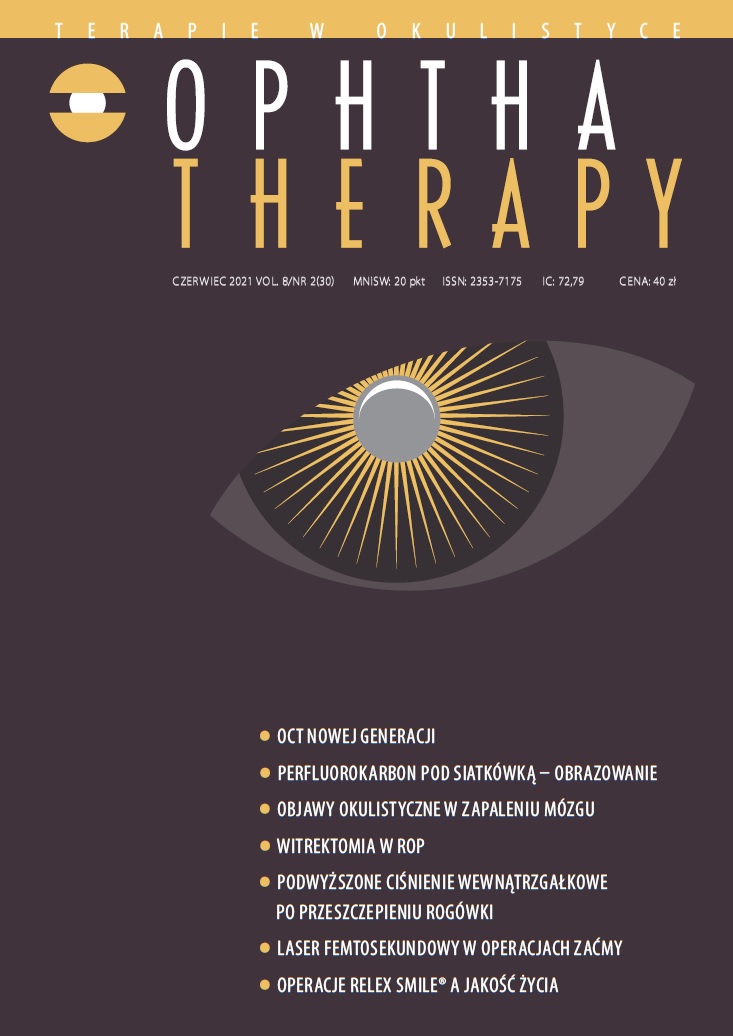Selected problems and challenges of ophthalmic care system in Poland Review article
Main Article Content
Abstract
In the perspective of 10–20 years, the ophthalmic care system in Poland will face numerous challenges, and the existing problems will increase. Due to the aging of the population, the incidence of refractive errors and chronic, age-related diseases such as presbyopia, AMD, diabetic retinopathy, glaucoma and cataracts will increase. Due to the change in lifestyle, the incidence of myopia is expected to increase among children and adolescents. The number of ophthalmologists and nurses will decrease and the average age of these professional groups will increase. The number of optometrists in Poland is low, and the legal aspects of practicing the profession of optometrists remain unregulated. Low social awareness contributes to late detection of eye diseases, which worsens the prognosis and increases the costs of treatment.
Downloads
Article Details

This work is licensed under a Creative Commons Attribution-NonCommercial-NoDerivatives 4.0 International License.
Copyright: © Medical Education sp. z o.o. License allowing third parties to copy and redistribute the material in any medium or format and to remix, transform, and build upon the material, provided the original work is properly cited and states its license.
Address reprint requests to: Medical Education, Marcin Kuźma (marcin.kuzma@mededu.pl)
References
2. Główny Urząd Statystyczny. Rocznik Demograficzny. 2018.
3. Główny Urząd Statystyczny. Stan zdrowia ludności Polski w 2014 roku. 2014.
4. Partyka O, Wysocki MJ. Epidemiologia chorób narządu wzroku oraz infrastruktura okulistyki w Polsce. Przegląd Epidemiol. 2015; 69: 905-8.
5. Grzybowski A, Kanclerz P, Tsubota K et al. A review on the epidemiology of myopia in school children worldwide. BMC Ophthalmol. 2020; 20: 1-11.
6. Zatrzymać epidemię ślepoty. Medyczny, społeczny i ekonomiczny obraz schorzeń siatkówki oka. Stowarzyszenie AMD, PZN, Retina AMD, Warszawa 2012.
7. Figurska M, Matysik-Woźniak A, Adamiec-Mroczek J et al. One-year outcomes of the Polish treatment program for the wet form of age-related macular degeneration using intravitreal therapy. Eur J Ophthalmol. 2020; 30: 586-94.
8. Instytut Innowacyjna Gospodarka. Ocena ekonomicznych kosztów obciążenia społecznego zaburzeń siatkówki ze szczególnym uwzględnieniem DME i AMD. Raport. Warszawa 2018.
9. Polskie Towarzystwo Okulistyczne. Jaskra – podstawowe informacje. Medycyna Praktyczna 2015.
10. Instytut Praw Pacjenta i Edukacji Zdrowotnej, Koalicja na Rzecz Walki z Cukrzycą. Cukrzyca 2025. Strategia prewencji i leczenia cukrzycy w Polsce 2015–2025.
11. Watch Health Care. Barometr Fundacji Watch Health Care nr 19/15/02/2019. www.korektorzdrowia.pl (access: 5.08.2020).
12. Watch Health Care. Dostęp do opieki okulistycznej w Polsce. Podejście systemowe. 2012.
13. Naczelna Izba Lekarska. Zestawienie liczbowe lekarzy i lekarzy dentystów wg dziedziny i stopnia specjalizacji. 2020.
14. Muc R, Pinkas J, Kołodziejski Ł et al. Finansowanie świadczeń okulistycznych w Polsce. Post N Med. 2017; 03: 117-23.
15. ECOO Blue Book. Data on optometry and optics in Europe. The European Council of Optometry and Optics. 2017.
16. Naczelna Izba Pielęgniarek i Położnych. www.nipip.pl (access: 7.12.2020)
17. Kozłowski P, Kozłowska M, Kozłowska K. Prevention of eye diseases among the residents of Lublin, Poland. J Education, Health and Sport. 2017; 7: 177-82.
18. Osęka M, Jamrozy-Witkowska A, Mulak M. System wczesnego wykrywania wad refrakcji i przewlekłych chorób oczu w Polsce. Stan obecny oraz propozycje rozwiązań na lata 2020–2030. Fundacja Profilaktyki Chorób Narządu Wzroku, Warszawa 2020.

